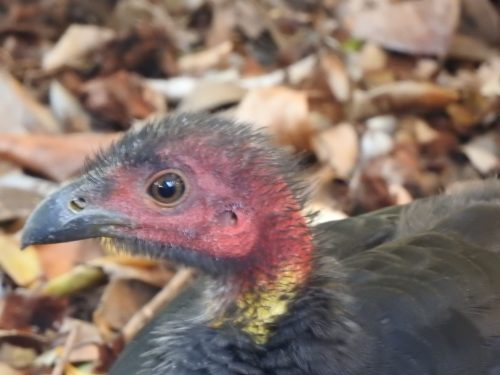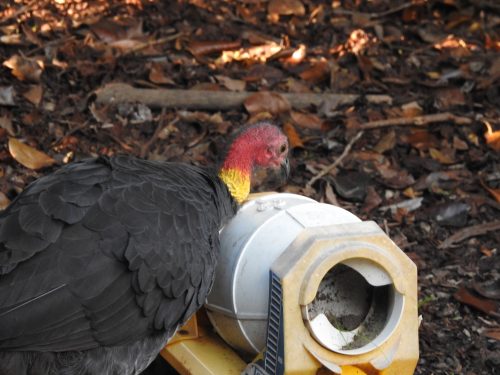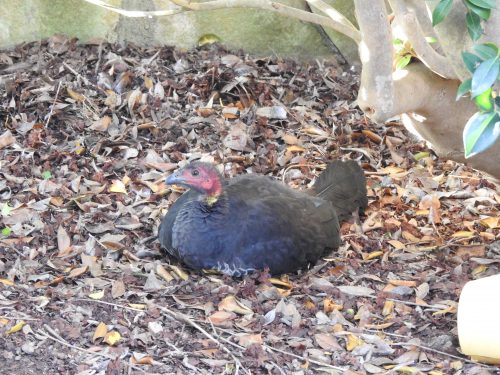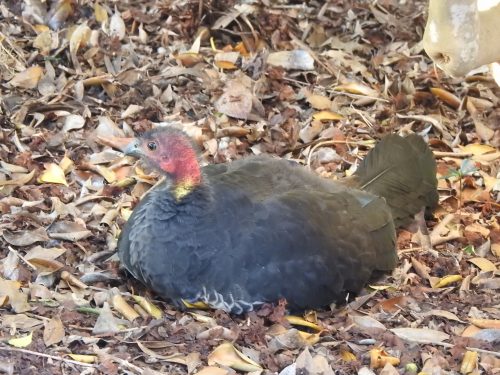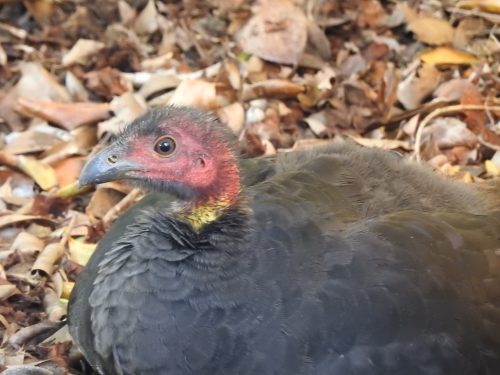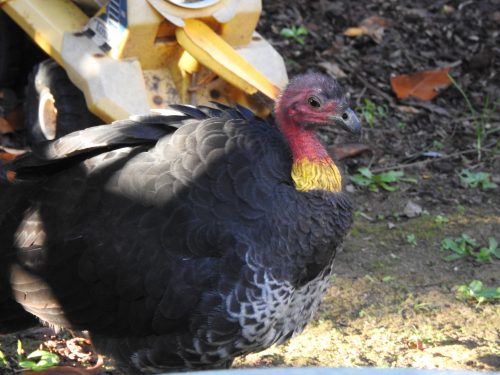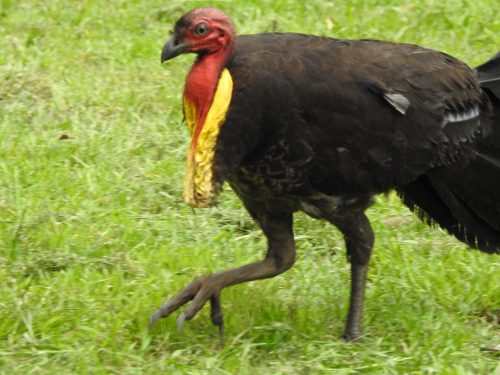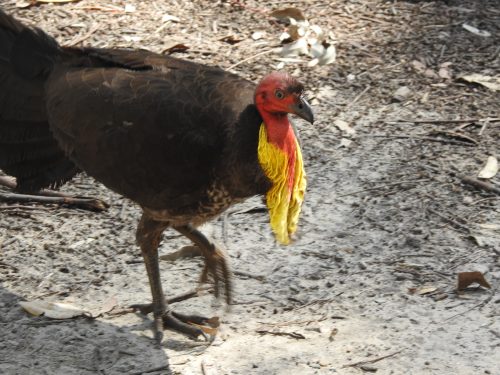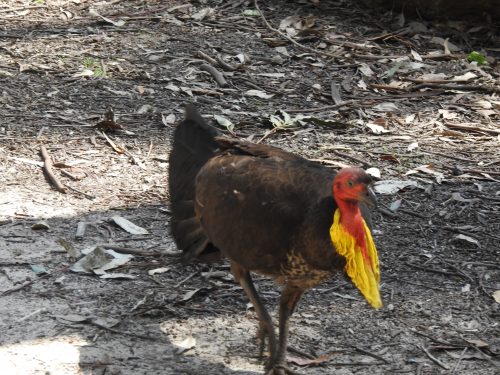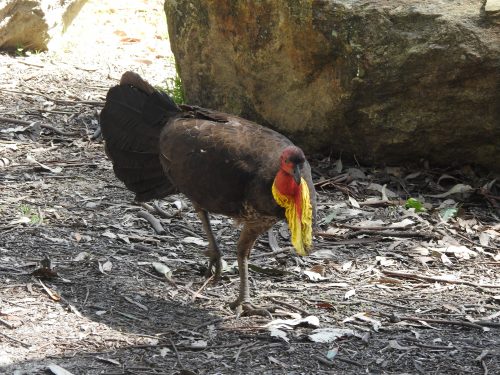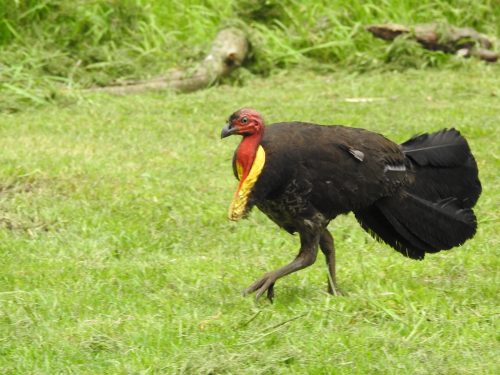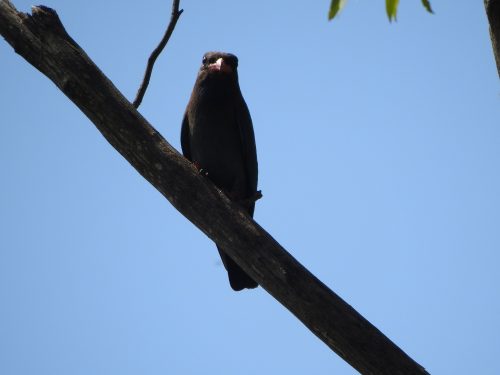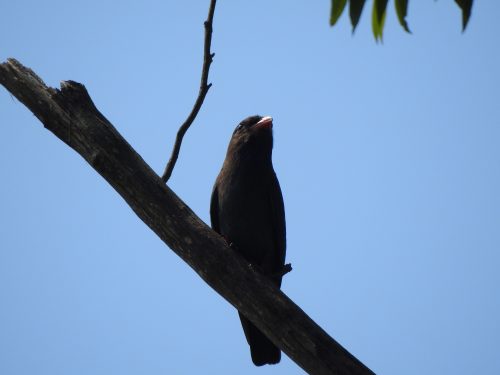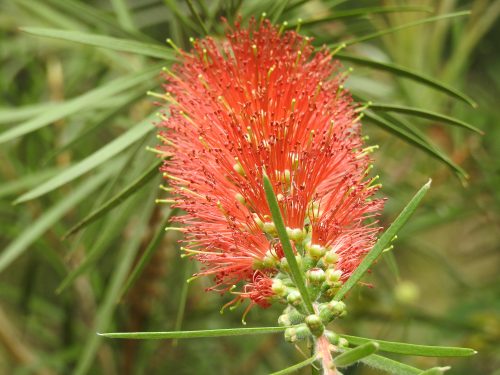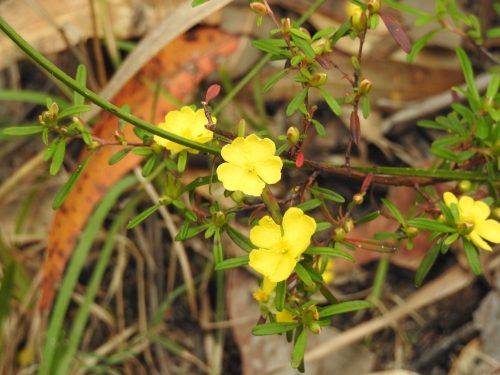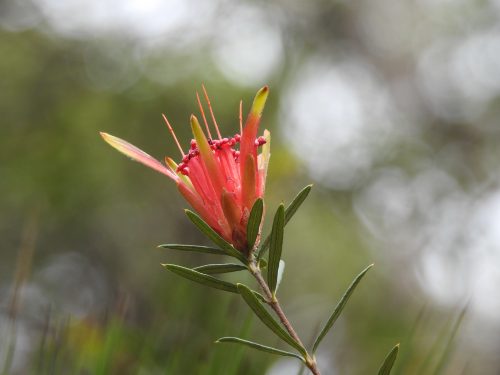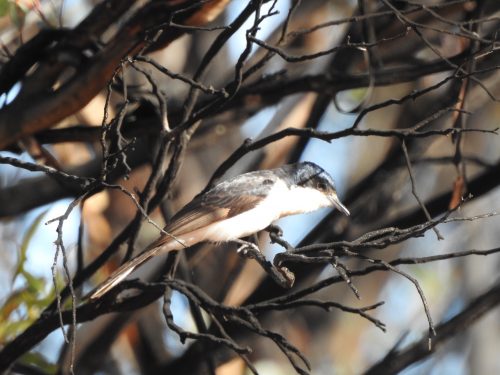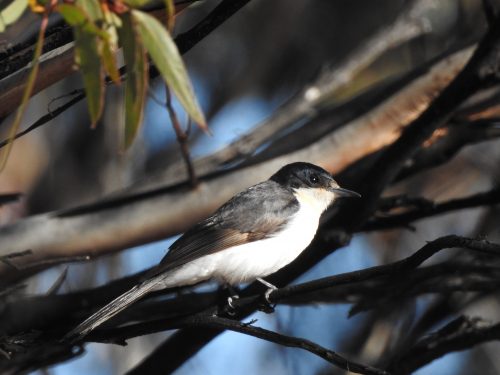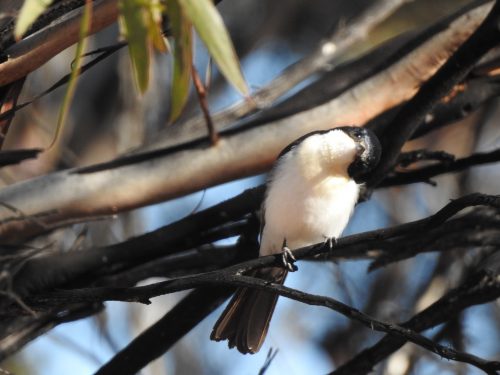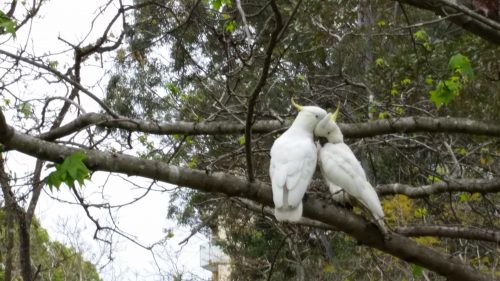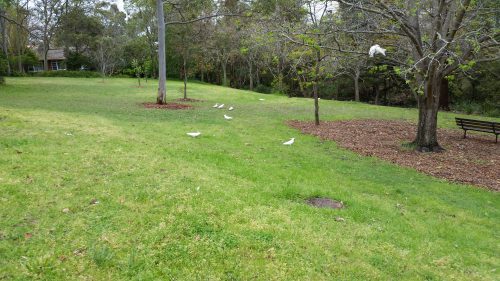Turkeys in the Garden
I am currently in Sydney visiting family. When we speak on the phone, my grandchildren often tell me that they have just seen several Australian Brushturkeys in their garden. They live in Artarmon and they know, however, that I like to know what birds they are seeing. I guess that this is quite a common, unremarkable event for many Sydney residents. For me, however, it is quite an unusual event. I live near Adelaide in South Australia and I never get turkeys visiting my garden. On the other hand, having a kangaroo or two in my garden is not unusual.
Three visitors
Several days ago I was able to see the three visiting turkeys in the back yard. I quietly crept outside with camera in hand and managed a few good shots, some of which I have shown here today. They were quite unconcerned about my presence some ten metres away clicking on my camera.
Leaf litter
In that particular part of the garden, there are several large bushes which constantly drop their leaves. There is quite a thick layer of leaf litter underneath the bushes, and the turkeys really enjoy scratching around looking for beetles and other tasty morsels.
While taking the photos I observed one of the birds checking out my grandson’s toy cement truck (see photo above). I am not sure what it thought of the toy but it must not have considered it to be potential food. I never saw it peck at the toy or any other toys lying nearby.
On visits to Sydney, I have frequently seen Australian Brushturkeys. I have often visited the nearby Lane Cove National Park and I have seen the turkeys there strutting around looking for some handouts from picnickers, dropped scraps of food and other tasty items. I can’t ever recall seeing one sitting down like one of the visitors to the garden (see photos above and below). I guess it needed a rest after walking the nearby streets.
Good birding,
Trevor.
Brush Turkeys in Lane Cove National Park
It is my impression that the people of Sydney, and Lane Cove in particular, as heartily sick of the Australian Brush Turkeys which invade their gardens. Granted – I will accept that this species of bird can create a mess with their scratchings in garden beds though I have not experienced that myself. I do not live in Sydney but I do visit my son and his family in Artarmon once or twice a year. While this bird occasionally comes into my son’s backyard, it never causes any harm. That is probably because there is nothing much for them to destroy; it’s mostly trees or bushes and the few garden beds in the front yard are very bushy too.
Usually, while I am visiting I like to spend some time in the Lane Cove National Park where the species is usually seen, sometimes in numbers. On my most recent visit last month I spent about four hours birding in the park. In total, I think I saw 5 different turkeys during my stay. I always like seeing them and taking photos of them. While they may be commonplace, ordinary and a nuisance to local people, I find them fascinating. This is because we do not have this species where I live in Murray Bridge, South Australia (an hour east of Adelaide). There are several introduced populations on Kangaroo Island just off the south coast of South Australia.
To be quite honest, however, there have been a few occasions where I have felt annoyance with this species. You can read about that incident here. Or in the further reading articles listed below.
Good birding,
Trevor
Further reading:
Dollarbirds in Lane Cove National Park
Last month I had the delight of spending a few weeks in Sydney with my son and his family. During this time I had the delight of attending my grandson’s 10th birthday party. These are special times indeed. Once the children had returned to school, I was free during the day to do some exploring on my own. On one of those days, I spent about four hours in the nearby Lane Cove National Park, a wonderful spot just ten minutes’ drive away. It was a mild, sunny day with a delightful breeze.
During my stay, I explored a few of the many picnic grounds and walking trails along the main road through the park, Riverside Drive. I made a pleasing list of the birds seen and heard, taking photos of those which came within camera range. I also found a lovely spot to have a picnic lunch and a cup of tea, overlooking one section of the Lane Cove River which runs through the park.
After lunch I still had about an hour to spare, so I drove over to the other side of the river and slowly drove along the Max Allen Drive, parking at the end of this road. I still had some hot water in my thermos so I made another cuppa. While I was enjoying my afternoon tea, I heard the calls of a bird I did not immediately recognise. One of the two birds landed where I could see it. I immediately recognised it as a Dollarbird. This was only my second ever sighting of this species – the other sighting being last year at the same time of year and in the same national park.
The two birds flew around a little while calling to each other. One landed within range of my camera so I took the photos shown above and below. Despite waiting for quite a long time, neither of the birds landed in a sunny position but stayed with the sun behind. I could have walked to the other side of the tree, but that would involve walking on the river. This means that my readers cannot see the lovely colours on the feathers. You can see a much better photo and more information about this species on the Birdlife Australia site here.
The Dollarbird is so-called because of the round, white spots underneath each wing when flying. Early observers thought that these looked like silver dollar coins. They are very prominent underneath a flying bird. They are widespread in eastern and northern parts of Australia but are absent in my home state of South Australia. (There are occasional sightings but these are vagrant individuals and are not resident in my state.) This species is a member of the Roller family of birds, with 11 other species in the family worldwide. The family name “roller” comes from their courtship display while airborne.
Next time I am in Sydney, I hope that I can get better photos of this species. I have also included below some of the wildflowers in bloom in the national park during my visit.
Good birding,
Trevor
Further reading:
Restless Flycatcher in Lowan Conservation Park
Several months ago I visited the nearby Lowan Conservation Park in South Australia. Lowan is a half-hour drive from where I live in Murray Bridge and just south of the small community of Bowhill. This small reservation is mainly mallee scrub with an understory of a great variety of plant species, including Acacias, Grevillia, Correa and many more.
It was a quiet, sunny winter’s afternoon and the birding was rather slow. To my delight, however, a Restless Flycatcher was flitting around nearby while I was having an afternoon tea break. Its Latin name is Myiagra inquieta which is very apt: “inquieta” is from the Latin inquietus which means “restless”. On every occasion I have seen this species it has indeed been restless. It is constantly on the move, often calling with a grinding sound which gives it one of its common names: scissors grinder.
While superficially it looks very similar to another member of the flycatcher family, the Willie Wagtail, it is easily distinguished by the white on the throat and its distinctive call. While it does occasionally wag its tail like the Willie Wagtail, it is more likely to hover just above the ground trying to disturb insects to snatch up for its next meal.
On this occasion, the bird I photographed for today’s post was very obliging. It would dart down to the ground to grab an insect and then return to the same perch in a tree nearby, usually always the same branch. This enabled me to focus on the one spot and to get some nice shots of it.
This species is widespread throughout eastern and southern Australia, but in my experience, it is not common anywhere in any numbers. The Willie Wagtail is far more common. I really enjoy coming across this species on my birding travels. I am happy to have the Willie Wagtail as a resident species in my garden, but it would be nice to have the Restless Flycatcher around more often than a fleeting visit every few years. I guess it is trying to tell me to get out birding more often.
I have included several more photos of the same bird below. I’m not sure what it was looking at in the final photo.
Good birding,
Trevor
Further reading:
Sulphur-crested Cockatoos preening
Last month on a visit to Sydney, I timed my arrival to coincide with my grandson’s 10th birthday party. I arrived about ten minutes before the guests started descending on the small park near Chatswood, a suburb of Sydney near where my son and his family live. It had been threatening to rain all morning, and the preceding few days had been quite wet. The children present at the party were all keen to get out and play. No amount of rain would deter them as we found out later.
While some games on the grass were underway, my attention was diverted from the children and their enthusiastic pursuits. A small flock of Sulphur-crested Cockatoos had flown in to a nearby part of the park. I slowly moved closer to get some photos of them on my phone. I just did not feel like walking all the way to the car to get my camera. The flock can be seen in the photo below, but I was more interested in the two birds in the photo above. They ignored me getting closer and closer. They appear to be whispering to each other in a quite romantic way. (Forgive me; it is the “story-teller” in me writing this.)
In reality, they are just preening each other’s feathers, something most parrots do regularly. In fact, all birds indulge in preening on a regular basis. Preening helps to keep the feathers clean and tidy, which in turn assists in flight and their general health and well-being. So, while I may have thought that this pair was being all loving to one another, what they are doing is actually very practical help.
Good birding,
Trevor
